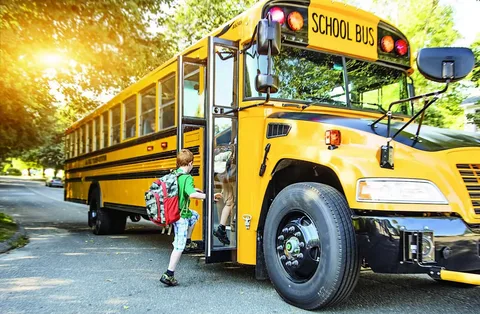Thomas Built Buses
The Beginning
The national trend in the United States in the 1920s and 1930s was toward use of personal automobiles rather than riding public transportation. As streetcar ridership decreased, less costly buses were often used in substitution by the companies operating the service. Orders for new streetcars and renovations began falling off.
Just as he had made the transition from wooden to steel streetcar building, Thomas and his workers at High Point also made the transition to building buses successfully. In 1934, Duke Power of South Carolina had Thomas build 10 transit buses. In 1936, Thomas ceased production of streetcars and launched a new product: the school bus. The same year, the company built 200 wooden-bodied school buses for the state of North Carolina, beginning a long tradition with that state which continues to the present day.
In the early days of the school bus, Perley Thomas and his company’s reputation for design innovation and quality manufacturing helped transform the industry. In the United States, many school buses in the 1930s were nothing more than flatbed truck chassis with wooden sides and a canvas roof, and had few or no safety devices.
In 1938, the company introduced the first welded all-steel bus body. In 1939, Dr. Frank W. Cyr of New York, who became known as “The Father of the Yellow School Bus”, hosted a 7 day long national conference of industry and school leaders which established 44 important safety standards and the yellow color for school buses all across the United States.The company became a major school bus body builder in the post-World War II period. By 1980, it was one of the big six school bus body companies in the United States.
Table of Contents
1972-1998: Thomas as an independent company
Thomas Built Buses, Inc. was incorporated in 1972 as the successor to Perley A. Thomas Car Works. In 1988, Thomas introduced its first company-designed bus chassis for its popular Saf-T-Liner transit-style bus; the Saf-T-Liner was sold for both for school and commercial use. In the past, Thomas was previously dependent upon truck chassis made by other companies for its transit-style school bus bodies (particularly Ford, Dodge, GMC, International Harvester and even Volvo), much like the majority of other school bus manufacturers. Thomas was the first school bus manufacturer to design its own chassis for both its front and rear-engine models, beating competitor Blue Bird by a decade (California manufacturers Crown Coach and Gillig Corporation did not manufacture a front-engine model that competed with Thomas).
The late 1970s and early 1980s was a period of struggle for school bus manufacturers. Coupled with the slow economy, manufacturers could no longer count on the factor that had driven school bus sales for the past two decades: the entirety of the baby-boom generation had finished school; it would be years before student populations would create sufficient demand again. During this time, a number of manufacturers either encountered financial difficulty or closed their doors altogether. Thomas diversified its product lineup, entering the small school bus market, creating unique products, and redesigning its transit-style buses to compete with newly-introduced competitors.
In 1980, the company began to manufacture a smaller school bus on a cutaway van chassis, the Thomas Minotour, which is still in production (as of 2010). Also in the 1980s, the company entered the commercial public transit bus market. In 1989, Thomas introduced the Thomas Vista school bus, a modified conventional design providing improved front-end visibility for drivers. Early in the 1990s, Thomas introduced the MVP (which stood for Maneuverability, Visibility, and Protection); a transit-style school bus, available in front and rear-engine models, the MVP was a lower-cost version of the standard Saf-T-Liner intended to boost sales. The front-engine MVP was still sold in 2010 as the Saf-T-Liner EF.
By the end of the 20th century, Thomas (along with Blue Bird and Ward successor AmTran) was one of only three principal builders of large school buses in the United States. It is still based in High Point, and in 1998, was acquired by the Freightliner Group of Daimler AG. Currently, Thomas employs over 1,600 people worldwide.
1998-present: A Division of Freightliner
In the 1990s, the school bus industry was changed by a number of acquisitions and mergers. Several of the acquiring firms were either truck manufacturers or custom chassis builders. In the case of Thomas, they were acquired in 1998 by the Freightliner division of Daimler AG (then DaimlerChrysler).
The purchase of Thomas came soon after Freightliner’s entry into school bus chassis production. In 1997, Freightliner had launched the FS-65 conventional school bus chassis based on its FL-Series medium duty truck; Freightliner was the first new chassis producer since Chrysler stopped production of Dodge school bus chassis in 1977. The purchase of Thomas allowed Freightliner to offer the FS-65 through a single body manufacturer, and the gamble worked. Throughout its production run, the FS-65 was used throughout many districts around the US. The last FS-65 was produced and delivered on December 13, 2006 to O’Brien Bus Service, Inc. of Maryland.
In 2004, Perley A. Thomas, founder of the Thomas streetcar and bus building companies, who died in 1958, was among the first inductees into the Raleigh-based North Carolina Transportation Hall of Fame.
In 2009, Thomas launched a new Type A design geared specifically towards the activity bus market called the MyBus. It is available in 3 sizes on a GM chassis.
(Thanks to Wikipedia for allowing the use of company history)


Lafayette Schools 96 International conventional.

Interior from the 70’s…This was standard, albeit not the safest. We have come a LONG way…

1974 Thomas ER.

2011 C2 Safe-T-Liner.

07 Conventional with a Freightliner chassis.

2009 C2 Safe-T-Liner.

Mid 80’s Vista model.

1993 Thomas Vista.

1987 Conventional.

First Student Safe-T-Liner EF.

Safe-T-Liner FE.

1975 conventional.

Charles County Freightliner conventional.

1983 conventional on Ford B-700 Chassis.

Conventional in International chassis.

Hillsborough County, FL, 2006 Freightliner conventional.

Gooding schools MVP ER.

Polk County, FL MVP ER.

Another Polk MVP ER.
More to Come!










